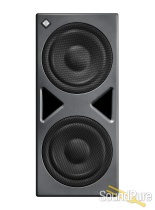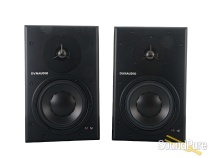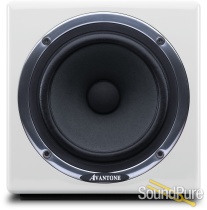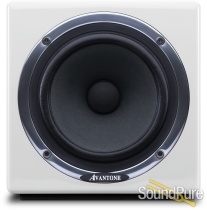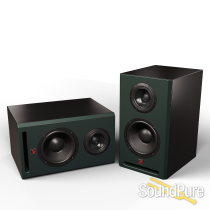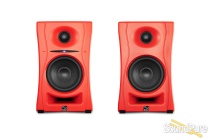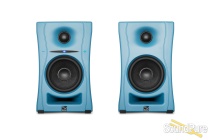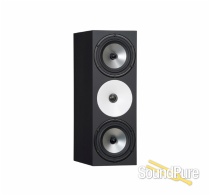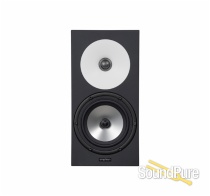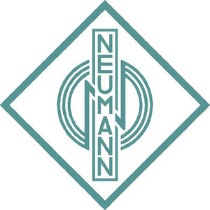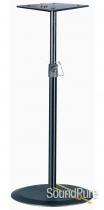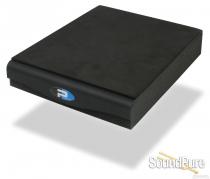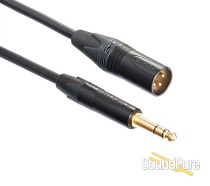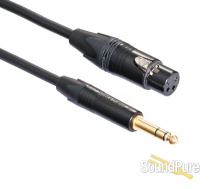-
Call Us Toll Free888-528-9703
-
Local/International (+1)919-682-5552
- Call Us! Toll Free! 888-528-9703
- Local / International (+1) 919-682-5552

Available for Special Order
See something you like? This item is gone, but not forever. It can be special ordered, and even customized!
We can get it fast!
Because of our special relationship with Neumann we can get this as fast, or faster than anyone in the industry. In some cases, we even have preferred build slots we can offer you.
Want to know when one lands?
Notify MeWant to discuss a special order?
Manufacturer's Description from Neumann
The goal: accurate, absolutely uncolored sound
Our aim with the O 300 D was to strive for nothing less than perfection in developing the best compact active reference monitor possible, with accurate, uncolored sound, superb transient response, and ideally shaped waveguides.
The O 300 D is a monitor which draws upon all of KLEIN + HUMMEL?s years of experience in monitor design, which has been fine-tuned through extensive computer simulations and countless listening tests. It is indeed unique in its class, for it does in fact deliver superlative sound absent of colorations, precise bass response, picture-perfect dispersion patterns, and a stunningly real soundstage with remarkable image focus and depth.
The advantages of the three-way system
To authentically re-create the sound captured in a recording-particularly a recording of the human voice-an active three-way system was chosen. In comparison with two-way monitors, the 300 D offers clear advantages that have been discussed in detail earlier in this catalog. The sophisticated three-way design employed in the O 300 D makes this loudspeaker system extremely precise and revealing of detail, and it enables the mixing engineer to make critical judgments with supreme confidence.
Exact localization and extraordinary sense of space
By utilising a dense, new, extremely low-resonance material called LRIM, we were able to mould the waveguides required for optimal dispersion directly into the baffle. The elliptical shape of the high-frequency horn makes the dispersion angle in the vertical plane more narrow thus reducing the amount of early reflections off the console surface which would otherwise interfere with the direct sound from the speakers (comb-filter effects), thereby improving spatial definition. At the same time, the effective horizontal listening area is made wider, giving the recording engineer greater freedom of movement in front of the console. The use of LRIM has also made it possible to align the acoustic centers of the two drivers exactly on one plane, parallel to the baffle, thereby preventing time and phase coherency problems at the crossover frequencies. This allows the individual drivers to work together perfectly to produce a precisely detailed soundstage.
Superb sonic qualities
For a loudspeaker system to achieve extremely flat frequency response and create an authentic reproduction of the original sound, its components need to be of very high quality, carefully manufactured, and selected for their compatibility with one another.
The 8 1/4? (210 mm) cone woofer is made of a special lightweight polypropylene material that has excellent self-damping properties. Its long-excursion voice coil enables this driver to produce very low frequencies at high sound pressure levels with practically no distortion. In contrast to common bass-reflex systems, which tend to blur the low end, the acoustic suspension system of the O 300 D delivers tight, articulate bass which is strikingly clear, detailed, and natural, particularly in transients.
The midrange is handled by a treated fabric dome with a dia-phragm/voice coil of 3" (76 mm) in diameter. Since its mass is much lower than that of cone drivers, it has the advantage of being able to achieve superior impulse response and extremely uniform amplitude response. As a result, midrange reproduction is impressively true-to-life, especially with the human voice.
The high-frequency driver is equipped with a titanium/fabric dome that combines the transparency of a titanium dome with the low distortion of a fabric dome. This driver has been finely matched to its elliptical waveguide, ensuring exceptional directivity.
All three drivers are magnetically shielded, allowing you to place the speakers directly next to video monitors or computers.
Precise room-matching
The O 300 D includes very flexible room-matching circuitry to alter the amplitude response of the monitor as needed, depending on speaker placement, in multiple steps and in three critically relevant frequency ranges. This flexibility can be instrumental in turning less than ideal room acoustics into a favorable listening environment.
High-performance amplification
Each of the three drivers in the O 300 D is powered by a high-performance amplifier that is exactly matched to the driver?s technical requirements and which embodies KLEIN + HUMMEL?s long years of audio experience. Precisely tuned electronic crossovers help provide proverbial operational reliability and high amplifier output with minimal distortion.
The monitor is equipped with effective protection circuitry designed to allow impulse peaks through and to respond with limiting only when a voice coil is in danger of thermal overload or a power amplifier runs the risk of overheating. Activation of the limiter is indicated by blinking of the illuminated K + H logo.
Future-proof digital input
The O 300 D is equipped with switchable inputs for analog signals and digital signals in both AES/EBU and S/P-DIF formats. The D/A converter incorporates the latests technology, has a wide dynamic range, 24-bit resolution, and accomodates sampling rates from 32 to 96 kHz.
The analog input of the O 300 D is tranformer-balanced and floating, utilising a superior quality transformer that, even at high volume levels and the lowest frequencies, helps achieve extremely low distortion.
The input sensitivity of +6 dBu allows you to connect all standard studio signal sources.
Unique: separate inputs for external processing
A special connector included as standard equipment on the back of the O 300 D gives you direct access to each of the three power amplifiers. This unique feature enables you to use an external digital controller PRO C 28 to modify the response to compensate for amplitude and phase anomalies resulting from the monitor?s placement in the room or the particular acoustic conditions of the studio. While this type of acoustical optimization will require the appropriate experience and equipment, it is certainly more economical than a structural renovation of the studio.
Solid MDF enclosure, award-winning design
The monitor stands out not only for its sound but also for its attractive, modern design, and in fact received an international design award in 1998. The sides of the cabinet are constructed of low-resonance MDF wood, and the front baffle is moulded of dense LRIM. The cabinet is available in either a charcoal-gray enamel finish or a rugged dark-gray nylon-fiber nap. The attractive metal grille is the final touch.
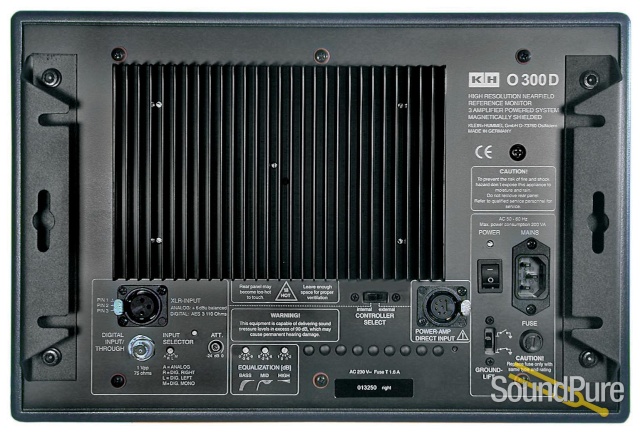
About Manufacturer
Specializing in some of the finest microphones in the world, Neumann has developed a top name in the industry for consistency, reliability, and sonic excellence. With microphones suited for the entire range of studio recording (and more recently live application), Neumann microphones are often a first choice for uncompromised acoustic reproduction.
Specifications
| Technical Specifications | O 300 D | |
| Free field frequency response 1 | 40 Hz - 20kHz, ± 2 dB | |
| Free field frequency response 2 | 35 Hz - 24kHz, ± 3 dB | |
| Self generated noise level at 10 cm | < 20 dB(A) | |
| THD < 0,5% at 1 m distance from | 100 Hz @ 95 dB/SPL | |
| Max. SPL | in half space at 3% THD 1m | 112,8 db/SPL |
| averaged between | 100 Hz and 6 kHz | |
| Elektronics | ||
| Woofer amplifier, cont. output power (THD < 0.1%) | 150 W | |
| Woofer amplifier, peak output power | 250 W | |
| Midrange amplifier, cont. output power (THD < 0.1%) | 65 W | |
| Midrange amplifier, peak output power | 75 W | |
| Tweeter amplifier, cont. output power (THD < 0.1%) | 65 W | |
| Tweeter amplifier, peak output power | 110 W | |
| Controller design | analog, active | |
| Crossover | Frequency | 650 Hz / 3,3 kHz |
| Slope | 18 dB/Oct | |
| Equalization | Low Cut | |
| Bass | 0;-2,5;-5;-7,5 dB | |
| Mid | 0;-1,5;-3;-4,5 dB | |
| High | 1;0;-1;-2 dB | |
| Protection circuitry | Limiter: Low, Mid, High | |
| Substronic filter | Frequency/slope | 30 Hz ; 6 dB/Oct |
| Input, analog | Impedance, electr. symm. | |
| Impedance, bal. floating | 14 kW | |
| Input sensitivity | + 6 dBu | |
| Attenuator | 0 ... 28 dB | |
| CMRR | > 60 dB @ 15 kHz | |
| In-/Output, digital | XLR, (BNC) | AES/EBU (AES 3id, S/P-DIF) |
| Impedance XLR | 110 W, bal. floating | |
| mpedance BNC | (75 W, non symm.) | |
| Switch, digital input | Analog / Digital- | |
| Left/Mono/Right | ||
| Digital Converter | Resolution, design | 24 bit DA, Då |
| Sampling rate | 32 kHz - 96 kHz | |
| Control lights | Power on | K + H-Logo "red" |
| Limit / Clip | K + H-Logo "blinking" | |
| Mains | 230 V AC | |
| Power consumption | Idle | 18 VA |
| Full output AC; DC | 240 VA | |
| Mechanical Specs | ||
| Dimension | Hight | 253 mm |
| Width | 383 mm | |
| Depth | 290 mm | |
| Net volume | Internal | 18,3 liters |
| Weight | 14,0 kg (30,9 lb) | |
| Drivers | magnetically shielded | |
| Woofer | 210 mm / 8" | |
| Midrange | 76 mm / 3" | |
| Tweeter | 25 mm / 1" | |
| Mounting points | 2 x M8 on sides | |
| Rear panel bracket | ||
| Mounting hardware | LH 25+LH 28 / LH 29 | |
| Cabinet surface | Painted or Flock finish | |
| Color | Standard | charcoal grey |
| Special (add-on price) | on request | |
| Baffle cover | metal grille, removable |



